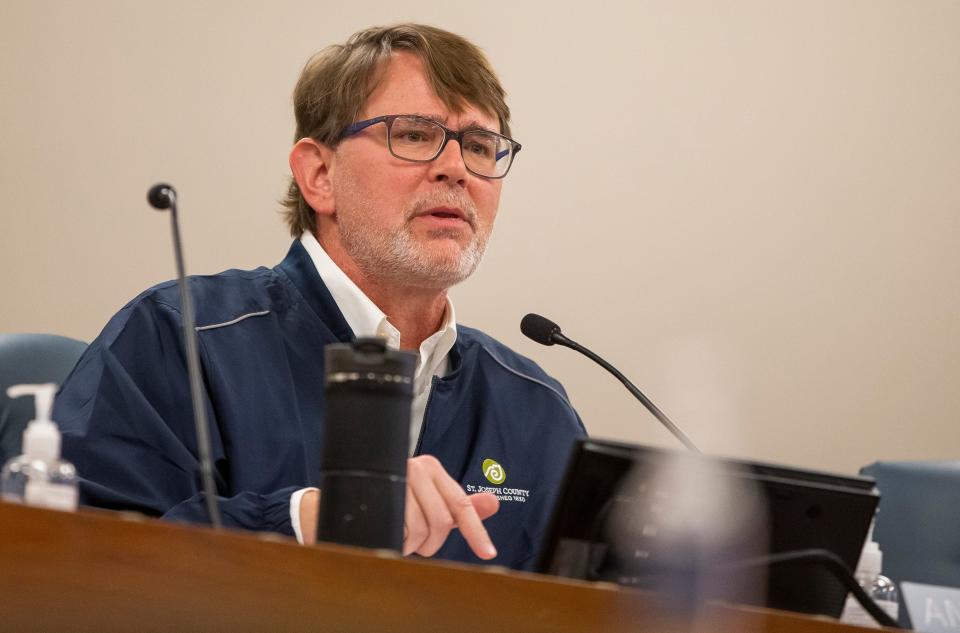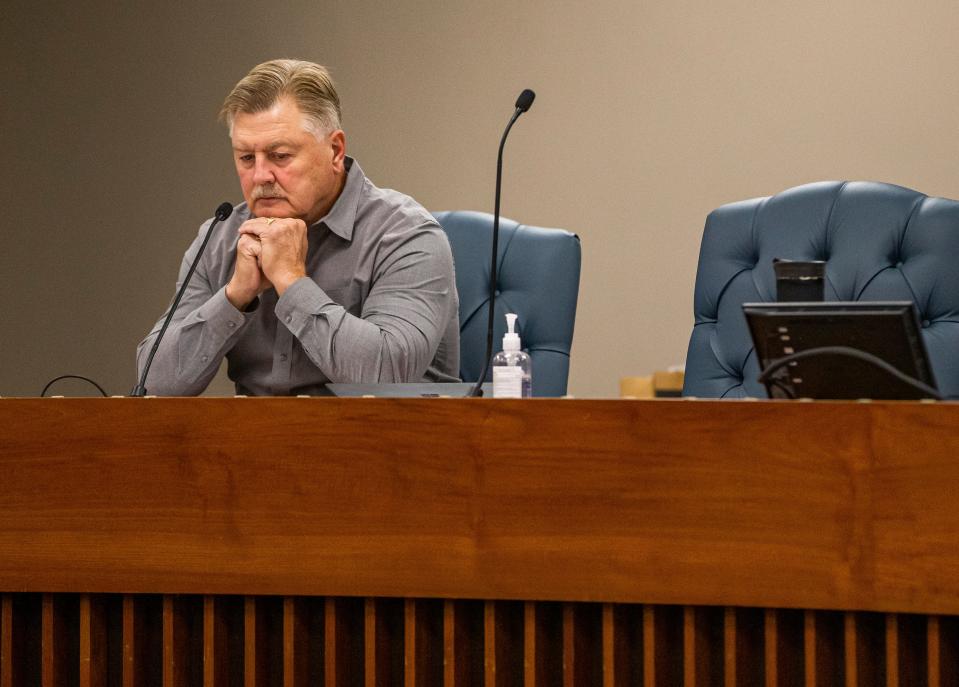Questions surround potential legal fight over St. Joseph County election maps
SOUTH BEND — A week after the St. Joseph County Commissioners approved controversial new district maps that could give Republicans the edge in local elections for the next decade, signs point to a legal fight over the redistricting plan — but the specifics of how a lawsuit might play out remain hazy.
The all-Republican commissioners, the county’s executive body, voted 2-1 last week in favor of maps that would give the GOP a bigger advantage in two commissioner districts, while shifting more Democrats and racial minorities to the third.
Two stronger Republican commissioner districts could also create more GOP-friendly County Council districts, because those districts must be drawn within the commissioner maps.
More: Readers weigh in on maps
On Tuesday, the Democrat-controlled County Council appears poised to take the first step toward suing over the new commissioner districts. The council is scheduled to hold a special meeting to discuss retaining the Indianapolis law firm Ice Miller for “litigation regarding redistricting.”
Earlier this month, all six council Democrats issued a statement saying they had “serious concerns regarding the legality and constitutionality of the proposed maps,” and that they were “apprehensive that any council maps that would be created based on these proposed Commissioner districts would therefore also be considered illegal and unconstitutional.”
But both the council’s potential legal strategy and a lawsuit’s prospects for success are unclear.
Council President Rafael Morton this past week said it was too early to discuss the council’s plan of action in detail, saying “all options are on the table.”
Commissioners President Andy Kostielney proposed the new maps with help from former Indiana House Speaker Brian Bosma’s law firm, Kroger, Gardis & Regas.
The council responded by hiring an Ice Miller legal team led by Kip Tew, a former state Democratic Party chairman, and another former Indiana House speaker, John Gregg, also a Democrat.

On one hand, the new commissioner maps drew intense criticism for moving all of South Bend’s urban areas into one confined district. Opponents say that was an example of “packing” most racial minorities into one district and diluting their influence in the other two, potentially amounting to a violation of the federal Voting Rights Act.
Democrats have hinted they may also challenge aspects of the state law that governs how St. Joseph County handles redistricting, which Indiana lawmakers recently tweaked to give the commissioners more control.
But claims of illegal voter dilution must clear a high bar in federal court, and the potential challenge to the state’s local redistricting law would be unknown territory, at least for St. Joseph County.
“In consultation with the Kroger firm, their opinion is these will stand at any level of court anyone would like to bring them in front of,” Kostielney said. “We’re confident the maps we’ve drawn are legal.”
Racial violations unclear
Kostielney and Commissioner Deb Fleming voted to pass the new districts last week, while they were opposed by fellow Republican Commissioner Derek Dieter, whose own re-election chances would be hurt by the changes.
The plan creates a stronger GOP edge in Districts 1 and 3, represented by Kostielney and Fleming, by taking all the suburban and rural areas from Dieter’s district. At the same time, Kostielney and Fleming’s districts would give up almost all their South Bend precincts and add those to Dieter’s, which would narrow District 2 to the city limits.
Kostielney said the goals of the plan were to give the districts equal populations, to avoid splitting “communities of interest,” such as South Bend or the county’s townships, into two or more districts, and to draw clean lines that eliminate oddities such as “island” precincts that belong to one district but are wholly surrounded by another.
Supporters of the plan say it makes sense for one of the three commissioners to exclusively represent South Bend residents, while the other two would represent suburban and rural voters.
But critics have said the maps are unfair on both political and racial grounds.
While the plan will ensure South Bend’s minority population can influence the election of one commissioner, opponents such as Trina Robinson, president of the local NAACP branch, say it could also guarantee that commissioner will always be voted down 2-1.
“We can’t say that to seclude one group of people in one area is a good idea,” Robinson said. “Every politician, be it Republican or Democrat, should be able to represent the whole community — our diverse community.”
Robinson said she is in contact with an attorney about the NAACP’s legal options.
However, while some opponents have said the new maps are unfair or even racially discriminatory, it’s far from certain whether a lawsuit could clear the high bar federal law has established for proving an illegal suppression of voting rights.
In a redistricting case, a claim of illegal dilution of minority voting rights must pass several tests.
One test requires that a minority group or coalition is large enough to elect the candidate of their choice. That means it must be possible for a district to be drawn in such a way that the minority group would constitute the majority of voters, not just help swing an election.
In fact, the new commissioner maps could come close to creating just such a coalition in District 2, where Blacks and other minorities would be the majority of the population and potentially capable of outvoting whites.
The current District 2 is almost 60% white, but under the new maps, the district’s total population will be less than 50% white. (Whites would still comprise a little more than half the voting-age population.)

And based on population figures alone, it appears unlikely the new maps could have deprived minorities of a similar voting bloc in Kostielney and Fleming’s districts, where minorities are not close to being half the population even under the current maps.
Whites comprise more than 73% of the total population in the current District 1 and almost 75% in District 3.
“To determine whether civil rights violation has occurred, it would be important to look at the demographic information about racial groups in the different districts and look carefully at the Black voter community’s ability to elect the candidate of their choice,” said Ami Gandhi, a voting-rights attorney with the Chicago Lawyers’ Committee for Civil Rights.
“We appreciate that the South Bend NAACP and other stakeholders have been vocal about the dangers of the redistricting process in St. Joseph County this time around,” said Gandhi, who is based in Indiana, but she added that “a more detailed analysis would determine if the events in St. Joseph County rise to the level of a legal violation.”
Special rules could face challenge
It’s even less clear how a lawsuit over St. Joseph County’s unique redistricting rules might play out.
Tew, one of the attorneys representing the council, alluded last week to the possibility the council could “challenge state law,” but he said he could not discuss specifics.
“We are still working with our client to figure out what their array of options are,” Tew said.
St. Joseph County’s redistricting has unfolded differently this year because of a recent change in state law that allowed the commissioners to pass their own district maps without approval by the council, the county’s legislative body. Because council districts must “nest” inside the commissioner maps, that also gave the commissioners more influence over the council’s process.
Another potential issue is whether St. Joseph County should be drawing new districts at all, after population changes in the 2020 census technically could have led to more changes to the local process.
State law gives St. Joseph County government a unusual structure, in that the three commissioners are elected in districts, instead of countywide. The nine-member council is unusually large, and its members are all elected in districts, whereas most county councils have some at-large members.
Rather than singling out St. Joseph County by name, state law applies those rules to counties between 250,000 and 270,000 population — of which St. Joseph is the only one. However, the 2020 census saw St. Joseph County surpass 270,000.
This past fall, state lawmakers passed legislation calling for counties to use 2010 Census figures in determining their redistricting process, meaning St. Joseph County would still follow the same rules.
But some South Bend-area Democrats, including state Rep. Ryan Dvorak and Sen. David Niezgodski, have suggested the rules now seem to be a legal gray area and will need further legal analysis.
While bitter fights over redistricting have been commonplace for decades in state and federal politics, redrawing maps has largely been a political non-issue at the local level, said Julia Vaughn, director of voting-rights group Common Cause Indiana.
But she said the controversy in St. Joseph County shows local governments could increasingly become redistricting battlefields.
“This has been blood sport at the state legislature since the 1990s, but typically it hasn’t been that controversial at the local level,” she said. “With more and more politicians recognizing the potential they have to improve their electoral outcomes and disadvantage their opponents, what’s going on in St. Joseph County is going to be replicated in other places across Indiana.”
This article originally appeared on South Bend Tribune: Details unclear in St. Joseph County election maps legal fight

